

Parent Information Session: mClass Date: November 6, 2017 Megan Ray: Literacy Coach/IRT Ashley Lewis: 3rd Grade Teacher
- Letter Naming Fluency (LNF) - First Sound Fluency (FSF) - Phoneme Segmentation - Fluency (PSF) Dibels - Dibels Oral Reading Fluency (DORF) - Nonsense Word Fluency (NWF)
Dibels: What and When? Your child’s grade level and time of year will determine which assessments your child will be given. BOY: Beginning of Year (September) MOY: Middle of Year (January) EOY: End of Year (end of May/June)
Letter Naming Fluency (LNF) Description: Your child will be shown a list of letters (not in alphabetical order). The teacher will be assessing how many of those letters the child can correctly identify in 1 minute. The child needs to say letter name, not sound. When: BOY Kindergarten - BOY 1st Grade
LNF: Helping at Home - Finding letters in text as you are reading together. - Cut out letters in a magazine and sort. - I spy at the grocery store, in the car, etc.
First Sound Fluency (FSF) Description: The teacher will say a word and the student will say the first sound in that word (not the first letter). Example: goat -> /g/ Purpose: Fluency in isolating and identifying 1st sound in words When: BOY and MOY Kindergarten
FSF: Helping at Home ● Take turns: You say a word and your child will tell you the first sound. Your child can think of a word and you will tell them the first sound. Point out pictures in a book and have your child tell you the ● first sound. ● Tell your child a sound and see how many words they can think of that start with that first sound.
Phoneme Segmentation Fluency (PSF) Description: The teacher will say a word and the student will separate and say all the sounds in 3- and 4- phoneme words. Example: goat -> /g/ /o/ /t/ Purpose: determine the ability to hear and manipulate the sounds in spoken words When: MOY Kindergarten - BOY 1st Grade
PSF: Helping at Home Using pennies, say a word. Have your child move up a penny for each sound in the word. Example: duck - d-u-ck (3 pennies)
PSF: Helping at Home 1. Beads on a pipe cleaner: move a bead over for each sound 2. Slinky: pull apart as you say each sound 3. Touching arm for each sound
Dibels Oral Reading Fluency (DORF) Description: The student will orally read 3 on-grade level passages. After 1 minute of reading, the student will retell what the passage was about. Purpose: determine the student’s word attack skills, fluency with on-grade level text and retell quality (1-3) When: MOY 1st Grade - EOY 3rd Grade
DORF: Helping at Home -Set timer for 1 minute -Have your child read text out loud -Have them retell what they read (in order and capturing the main idea) EOY Goals 1st Grade: 47 words per minute 2nd Grade: 87 words per minute 3rd Grade: 100 words per minute
Nonsense Word Fluency (NWF) Description: The student will read make believe CVC or VC words. The goal is for the child to read these words with automaticity, using short vowel sounds. Purpose: to identify and blend sounds in consonant-vowel-consonant and vowel-consonant words When: MOY Kindergarten - BOY 2nd Grade
Nonsense Word Fluency (NWF)
Text Reading Comprehension (TRC) Levels B-E Levels F-U - Student will read the text to the - Student will read the text or part of teacher. the text to the teacher. - Student will re-read text - With the text, the student will independently. answer 5 oral comprehension - Without the text, the student will questions. retell the beginning, the middle and - With the text, the student will the end of the text. answer two written comprehension - With the text, the child will answer questions. 5 oral comprehension questions.
Scoring Written Comprehension Level 3: Complex Level 2: General Level 1: Minimal Addresses the Addresses the Minimally addresses ↖ ↖ ↖ demands of the the demands of the demands of the question. question question. Effectively uses Uses text-relevant Uses minimal ↖ ↖ ↖ information to show information to show text-relevant information to clarify understanding. understanding of the or extend text in relation to the question understanding.
Sentence Starters: Providing Evidence • According to the text… • Based on the text… • On page __, it said… • The author wrote… • The picture showed me… • I know this because…
Home Connect Letter
Recommend
More recommend